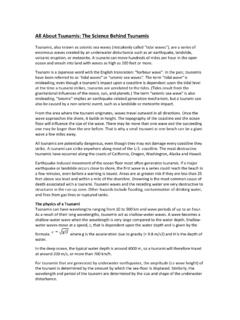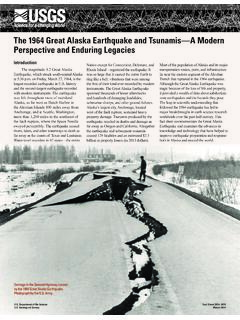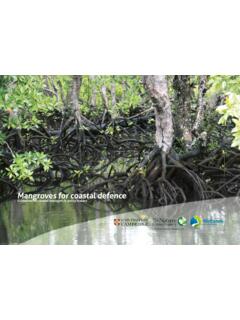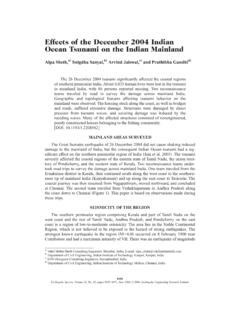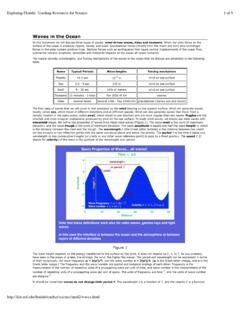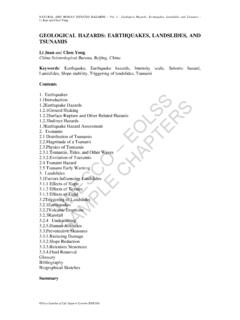Transcription of 1. Ocean Wave Spectra - MIT OpenCourseWare
1 Design Principles for Ocean VehiclesReading # Design Principles for Ocean Vehicles Prof. Techet Spring 2005 1. Ocean Wave Spectra 1. Wave energy Spectra . Red text indicates wave generation mechanisms and blue text indicates damping/restoring forces. The majority of Ocean waves are wind generated. Other wave generating mechanisms include earthquakes and planetary forces. Planetary forces drive tides and cause long 2004, 2005 A. H. Techet 1 Version , updated 2/24/2005 Design Principles for Ocean VehiclesReading # period waves on the order of 12 to 24 hours. Earthquakes are the major cause of tsunamis which, while rare, can be catastrophic if the earthquake occurs near or on the coast.
2 waves also encounter forces that tend to restore them to a flat surface. For small wavelength (high frequency) waves surface tension plays a large role in damping out these waves . The majority of waves are restored by gravity and longer period waves are damped by the Coriolis force. As wind begins to blow (between - 2 knots) on a calm surface small ripples, capillary waves or cat-paws , tend to form. These small waves are on the order of less than 2 cm. As the wind becomes stronger wave amplitude increases and the waves become longer in order to satisfy the dispersion relationship. This growth is driven by the Bernoulli effect, frictional drag, and separation drag on the wave crests.
3 Wind must blow over long periods of time and large distances to reach a fully developed sea state. When the phase speed of the wave crest matches the wind speed non-linear interactions stop (except friction) and the phase speed is maximized. The limiting frequency of the waves can be determined by the equation for phase speed and the dispersion relationship: w kgC U =/=/w (1) pw gw (2) c Uw where U is the wind speed and w is the limting frequency. Once wind stops viscositywcerodes the waves slowly. The smallest wavelengths decay the fastest. Sample spectrum shapes are shown in figure 2.
4 2004, 2005 A. H. Techet 2 Version , updated 2/24/2005 Design Principles for Ocean VehiclesReading # For a storm with wind speed, U , the effects of the storm can be felt at a distance from thew e storm, R . The number of wave cycles between the storm and the observation location is -g t 2 42NR=/l . The amplitude of the waves decays as where g = 2n k = 2nw /g (from Landau and Lifshitz). The development of storms can be tabulated. Fetch is the length over which the wind must blow to have fully developed seas (given in standard miles), and the storm duration, given in hours, is the time the storm must last to result in a fully developed sea.
5 Wind warnings Beaufort scale Wind speed (mph) Fetch (miles) Storm duration (hr) 3-4 12 15 3 small craft 5-6 25 100 12 7 35 400 28 gale 9 50 1050 50 hurricane 70+ 2004, 2005 A. H. Techet 3 Version , updated 2/24/2005 Design Principles for Ocean VehiclesReading # 2. Typical Wave Spectra Researchers have studying Ocean waves have proposed several formulation for wave Spectra dependent on a a number of parameters (such as wind speed, fetch, or modal frequency). These formulations are very useful in the absence of measured data, but they can be subject to geographical and seasonal limitations. Most Ocean wave Spectra take a standard form following the mathematical formulation: BS +() = A 5 e-/w4 (3) w w The frequency peak is called the modal frequency.
6 The area under the spectrum is the zeroth moment, M , which may be defined in terms of the significant wave height. For ao narrow-banded spectrum the significant wave height is approximately four times the square root of the zeroth moment. Since the significant wave height depends on the wind speed, the spectrum could be formulated in terms of the wind speed instead of the significant wave height. While certain Spectra can have more than one peak, it is assumed that a single storm produces a single-peaked spectrum and any second peak is due to a distant storm that sends waves to the considered location.
7 Several more specific theoretical representations of wave Spectra have been developed using data collected by observation platforms and satellite data in various regions. These Spectra are discussed below. When considering which spectrum formulation it is important to take into account the specific criteria that were used in developing the spectrum. Typically parameters that influence the spectrum are: Fetch limitations, whether the location we are considering has some physical boundaries that do not permit the waves to fully develop. Whether the seas are developing or decaying Seafloor topography: Deep water wave Spectra are invalid in shallow waters, and vice versa.
8 It may also be necessary to account for wave diffraction. Local currents: Strong currents may significantly impact the wave spectrum 2004, 2005 A. H. Techet 4 Version , updated 2/24/2005 Design Principles for Ocean VehiclesReading # Presence of swells: Swells are waves that result from distant storms that travel a significant distance and arrive often at an angle that differs from the wind direction. If we use a spreading function to correct a unidirectional spectrum it will not account for the presence of swell. It is also important when measuring waves that the component that results from swell be accounted for separately.
9 The Pierson-Moskowitz spectrum (equation 11) was developed for fully developed seas in the Northern Atlantic Ocean generated by local winds. S +() = 81 g 2 -0032( g/zw22 w . e . ) (4) 5103 w where z is the significant wave height, /z H 13 =4 M , (5) o and w is the modal frequency,mw =. z04 g /. (6) m This spectrum is developed under the following conditions: unidirectional seas, North Atlantic Ocean , fully developed local wind generation with unlimited fetch. The most critical of these assumptions is the fully developed assumption. For it is possible to achieve a larger heave response for a platform from a developing sea, even though the significant wave height may be smaller that that of a fully developed sea, since the modal frequency is higher and heave motions tend to have higher natural frequencies.
10 In the case of a rolling ship the decaying sea might excite a larger roll motion since the natural frequency of roll tends to be relatively low. In order to overcome the limitation of fully developed seas, a two parameter spectrum was developed. This spectrum is the Bretschneider spectrum (equation 14). The B-S spectrum 2004, 2005 A. H. Techet 5 Version , updated 2/24/2005 Design Principles for Ocean VehiclesReading # replaced the Pierson-Moskowitz spectrum as the ITTC standard. 4 S + () = 1 25 wm -125 (ww)4 mw . ze ./ (7)4 w5 where again, zis the significant wave height, /z H 13 = 4 M , (8)o If wsatisfies equation 13 then equation 14 reduces to equation 11.










![Natural Disasters | 5E Lesson Plan for Grades 3-5 [PDF]](/cache/preview/8/0/9/c/e/7/2/f/thumb-809ce72f931e610fe94c698182f94da5.jpg)
